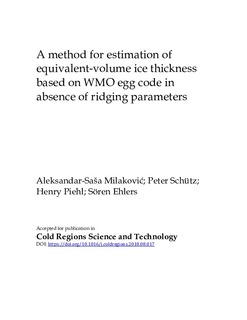| dc.contributor.author | Milakovic, Aleksandar-Sasa | |
| dc.contributor.author | Schütz, Peter | |
| dc.contributor.author | Piehl, Henry Peter | |
| dc.contributor.author | Ehlers, Sören | |
| dc.date.accessioned | 2018-08-30T07:19:26Z | |
| dc.date.available | 2018-08-30T07:19:26Z | |
| dc.date.created | 2018-08-29T13:14:02Z | |
| dc.date.issued | 2018 | |
| dc.identifier.issn | 0165-232X | |
| dc.identifier.uri | http://hdl.handle.net/11250/2559962 | |
| dc.description.abstract | When calculating equivalent-volume ice thickness along a vessel's projected route for the purpose of ice resistance estimation, information on both undeformed ice (level ice) and deformed ice (mainly ridges) is needed. Level ice information can be obtained from egg code-based ice charts in form of World Meteorological Organization (WMO) ice thickness ranges. Ridging parameters are sometimes available in ice charts as a supplement to the egg code, but are often missing, especially for the areas in the Arctic, in which case area- and season-specific values of these parameters are obtained from the databases. In this paper, limitation of the latter approach is presented, showing that when the currently available ridging parameters for the Arctic are used, the expected amount of ice along the route underestimates the one measured by a submarine by 29%. As an alternative approach, a novel method for estimating the equivalent-volume ice thickness without requiring ridging parameters is presented. It proposes substitution of WMO ice thickness ranges (currently accounting only for the level ice) with equivalent-volume ice thickness ranges (EVITRs), accounting both for the level ice and for the deformed ice features. The method is based on correlating the amount of deformed ice to the stage of development of the ambient level ice, by analyzing a series of ice thickness profiles for a certain area and season. Consequently, the method provides a mean for the estimation of the total amount of ice and its components along the route based only on the information available in the egg code. The results of a case study in the Arctic show an increased accuracy of the EVITR-based method compared to the ridging parameters-based method, reducing the average error in estimation of the total amount of ice along the vessel's route from 29% to 2%. | nb_NO |
| dc.language.iso | eng | nb_NO |
| dc.publisher | Elsevier | nb_NO |
| dc.rights | Attribution-NonCommercial-NoDerivatives 4.0 Internasjonal | * |
| dc.rights.uri | http://creativecommons.org/licenses/by-nc-nd/4.0/deed.no | * |
| dc.title | A method for estimation of equivalent-volume ice thickness based on WMO egg code in absence of ridging parameters | nb_NO |
| dc.type | Journal article | nb_NO |
| dc.type | Peer reviewed | nb_NO |
| dc.description.version | acceptedVersion | nb_NO |
| dc.source.journal | Cold Regions Science and Technology | nb_NO |
| dc.identifier.doi | 10.1016/j.coldregions.2018.08.017 | |
| dc.identifier.cristin | 1605275 | |
| dc.description.localcode | © 2018. This is the authors’ accepted and refereed manuscript to the article. Locked until 29.8.2020 due to copyright restrictions. This manuscript version is made available under the CC-BY-NC-ND 4.0 license http://creativecommons.org/licenses/by-nc-nd/4.0/ | nb_NO |
| cristin.unitcode | 194,64,20,0 | |
| cristin.unitcode | 194,60,25,0 | |
| cristin.unitcode | 194,64,93,0 | |
| cristin.unitname | Institutt for marin teknikk | |
| cristin.unitname | Institutt for industriell økonomi og teknologiledelse | |
| cristin.unitname | Institutt for havromsoperasjoner og byggteknikk | |
| cristin.ispublished | false | |
| cristin.fulltext | postprint | |
| cristin.qualitycode | 2 | |

